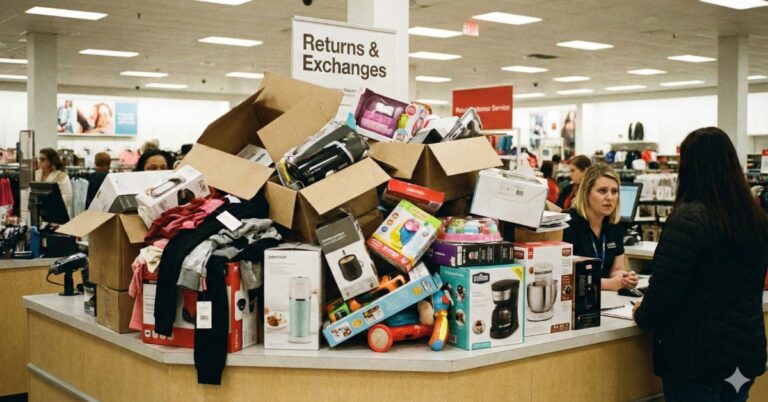
Retail Return Policy Changes in 2025 reflect growing pressure on retailers to manage reverse logistics, control losses, and balance customer convenience with profitability.
Black Friday is no longer just about the lowest price; it is about the exit strategy. Shoppers are becoming increasingly risk-averse, with data from the UPS Pulse of the Online Shopper revealing that 88% of shoppers now review a retailer’s return policy, and 66% do so before they even make a purchase.
This means your return policy is just as critical as your product photos. If your terms are hidden or too strict, you risk losing the sale before it happens.
However, if they are too lenient, you face the crushing weight of reverse logistics costs that are eroding margins across the industry. Navigating this balance is harder than ever as major players quietly tighten their rules.
Retail Return Policy Changes in 2025 Could Reshape Holiday Buying
Invesp"Nearly 30% of all products bought online are returned, compared to just 8.89% from brick-and-mortar stores."
Retailers are facing a massive financial drain, with returns costing U.S. businesses nearly $890 billion annually, according to the National Retail Federation. This staggering figure is forcing companies to rethink their strategies as retail return policy changes in 2025 begin to take effect across the industry.
The cost of retail returns involves expensive reverse logistics, including shipping, inspecting, and often liquidating products that cannot be resold at full price. Furthermore, businesses are aggressively combating Wardrobing return fraud, where consumers wear items once before sending them back or falsely claim packages never arrived.
Online shopping lacks sensory cues like touch and fit, causing the return rate for digital purchases to reach nearly three times that of brick-and-mortar stores. As Holiday shopping trends 2025 push more volume online, projected e-commerce return rates 2025 remain high, continuing a pattern seen since the pandemic when returns jumped to 16.6% of total sales.
Supply chains are designed to move products forward to the consumer, making the backward flow of returns slow and costly. To balance customer goodwill with profitability, many brands are quietly tightening their rules rather than raising prices during inflationary times.
Retailers are implementing several defensive measures to protect margins:
- Restocking Fees – Some direct-to-consumer brands now charge small fees for returns to offset processing costs.
- Shorter Windows – Major retailers like Sephora and Ulta have reduced their return periods, moving from 60 days down to 30.
- Anti-Fraud Tags – Large “do not remove” tags are being attached to apparel to prevent customers from wearing items before returning them.
- Store Credit Only – More companies are offering store credit rather than cash refunds to ensure revenue stays within the company.
Shoppers should scrutinize the fine print before clicking buy, as these critical updates are rarely advertised prominently. Essential Black Friday shopping tips now include verifying return windows and prioritizing in-store returns to avoid shipping delays and fees.
These insights on supply chain complexities and consumer behavior were highlighted in a report from The Conversation article by Lauren Beitelspacher.
Amazon Expands Drop-Off Network to Combat Logistics Costs
While many brands are responding to margin pressures by making returns harder, Amazon is taking a different approach by expanding its physical footprint to lower processing costs. The e-commerce giant is currently testing self-serve kiosks inside Goodwill thrift stores to streamline its reverse logistics management strategy.
This initiative has launched with 21 locations across the Seattle area, offering customers a new drop-off option beyond Whole Foods and Amazon Fresh. The move aligns with broader Retail Return Policy Changes in 2025 that prioritize operational efficiency without necessarily punishing the consumer.
The process is designed to fit seamlessly into the current Amazon seller return policy, allowing customers to drop off items without a box or shipping label. Users simply scan a QR code sent by Amazon, bag the item in provided plastic, and deposit it directly into the kiosk bin.
To encourage adoption of these high return rate solutions, the kiosks offer unique incentives such as a 20% off coupon for Goodwill merchandise upon completion. The system also collects data by surveying users about their thrift store shopping habits and immediate purchase intent.
Strategic partnerships like this allow Amazon to consolidate packages and significantly lower the cost of shipping compared to individual home pickups. This helps the platform maintain its free return standards while managing e-commerce profit margins effectively during high-volume periods.
For third-party sellers, these streamlined networks are essential to control overhead, though the ultimate goal remains to reduce Amazon FBA returns frequency overall. This innovative testing of thrift store kiosks was originally reported in a GeekWire article by Taylor Soper.
Key details of the Amazon x Goodwill partnership include:
- Locations – The pilot program covers 21 Evergreen Goodwill stores in the Seattle region, including Redmond.
- Convenience – The service is free, box-free, and label-free, utilizing a simple QR code system.
- Incentives – Customers receive a discount coupon for the thrift store after finishing their return.
- Access – This expands drop-off availability for rural customers who may not live near a Whole Foods or Kohl’s.
- Traffic – The partnership drives foot traffic to Goodwill, benefiting the non-profit while solving Amazon’s logistics challenge.
Extended Holiday Windows Offer Flexibility Amidst Stricter Rules
While Amazon is actively streamlining the “where” of returns through new drop-off partnerships, the company is also addressing the “when” by expanding return windows for the holiday season. Orders placed for most items between November 1 and December 31 are now eligible for return until January 31, 2026, provided they are in original condition.
This strategic move aims to make gift-giving worry-free, though shoppers must remain attentive to specific Retail Return Policy Changes in 2025 that may affect eligibility. For instance, Apple-branded products have a tighter deadline, with returns only accepted through January 15, 2026, even if purchased within the holiday window.
Refunds typically take up to 30 days to process once the item is received and inspected by the seller. Customers should also be aware that standard exclusions still apply to high-risk categories, such as perishables, customized products, and items marked as “Final Sale.”
Amazon is not alone in adjusting its calendar, as other major retailers have synchronized their policies to compete for holiday market share. These comprehensive details regarding holiday timelines were reported in a USA Today article by Saman Shafiq.
Key Holiday Return Deadlines for 2025:
- Amazon – Purchases from Nov. 1 – Dec. 31 are returnable until Jan. 31, 2026 (Apple products until Jan. 15).
- Walmart – Items bought from Oct. 1 – Dec. 31 are returnable until Jan. 31, 2026.
- Macy’s – Most purchases from Oct. 6 – Dec. 31 are returnable until Jan. 31, 2026.
- Best Buy – Purchases from Oct. 31 – Dec. 31 are returnable until Jan. 15, 2026 (excludes third-party contracts).
- Target – For items bought Nov. 1 – Dec. 24, the standard return window counter does not begin until Dec. 26.
Common Amazon Return Exclusions:
- Perishables and groceries.
- Automobiles and redeemable products.
- Amazon Pharmacy orders and pet medication.
- Products posing health or safety risks.
Returns Become the New Battleground for Customer Loyalty
While extended return windows offer a temporary reprieve for holiday shoppers, the underlying infrastructure of reverse logistics is undergoing a massive overhaul to secure profitability. The 2025 Returns Landscape report reveals that 81% of consumers review return policies before making a purchase, proving that Retail Return Policy Changes in 2025 are a decisive factor in conversion rates.
Retailers estimate that 15.8% of total annual sales will be returned this year, creating an $850 billion challenge that tests logistics teams across the board. To mitigate these losses, savvy brands are turning to Amazon account audit services to identify discrepancies and investing in FBA reimbursement recovery to claw back revenue from mishandled inventory.
Fraud continues to plague the industry, with approximately 9% of returns involving deceptive practices like empty boxes or label tampering. In response, 85% of retailers are now utilizing artificial intelligence and rigorous Amazon return rate analysis to detect illicit behavior before it impacts the bottom line.
Despite these defensive measures, consumer demand for convenience remains non-negotiable, with 86% of shoppers preferring no-box, no-label options for immediate refunds. Implementing these frictionless experiences while tightening security is the most effective way to Protect Amazon seller margins, a strategy frequently highlighted in My Amazon Guy consulting for brand growth.
Data regarding these shifting consumer expectations and fraud prevention tactics was sourced from a UPS article regarding the 2025 Returns Landscape report.
Key Findings on the 2025 Returns Landscape:
- Consumer Scrutiny – 81% of shoppers read the return policy before buying; 71% will not shop with a retailer again after a poor returns experience.
- Financial Impact – Returns are projected to cost nearly $850 billion this year, representing 15.8% of total sales.
- Fraud Prevention – 85% of retailers now use AI to combat return fraud, which accounts for 9% of all returns.
- Convenience Is King – 86% of consumers prefer box-free, label-free returns, and 82% prioritize free returns above all else.
- Operational Focus – 64% of retailers have made upgrading their returns capabilities a top priority for the next six months.
Regulatory Pressure Hits Amazon with $2.5 Billion Settlement
While retailers fight for customer loyalty through returns, Amazon is simultaneously addressing a massive regulatory challenge that impacts its most loyal user base. Our Amazon agency previously reported that the Federal Trade Commission has secured a historic $2.5 billion settlement regarding deceptive Prime enrollment practices.
This massive agreement aims to resolve allegations that Amazon tricked consumers into signing up for subscriptions and made the cancellation process unnecessarily difficult. The deal mandates that eligible customers will receive automatic refunds of up to $51, a move that underscores the financial stakes of Retail Return Policy Changes in 2025 and broader consumer protection trends.
Refunds are targeting customers who signed up for Prime between June 2019 and June 2025 but did not utilize the service’s benefits more than three times in a year. Amazon has not admitted any wrongdoing, stating instead that the settlement allows the company to move forward and continue innovating for its users.
Eligible members do not need to take immediate action, as Amazon is sending emails to notify those entitled to an automatic payout. The funds can be transferred conveniently via PayPal or Venmo, or delivered as a traditional mailed check for those who prefer physical payment.
For those who believe they qualify but do not receive an automatic notification, a formal claims process is scheduled to open on December 24. These customers can visit https://www.subscriptionmembershipsettlement.com/ to submit their claim online and verify their eligibility for the refund.
These details regarding the settlement and refund procedures were originally reported in an ABC News report by Kelly McCarthy.
The Silicon Review"In high-velocity sectors such as fashion, consumer electronics, and home furnishings, return rates often exceed 30%, with seasonal peaks reaching 40–50%."






